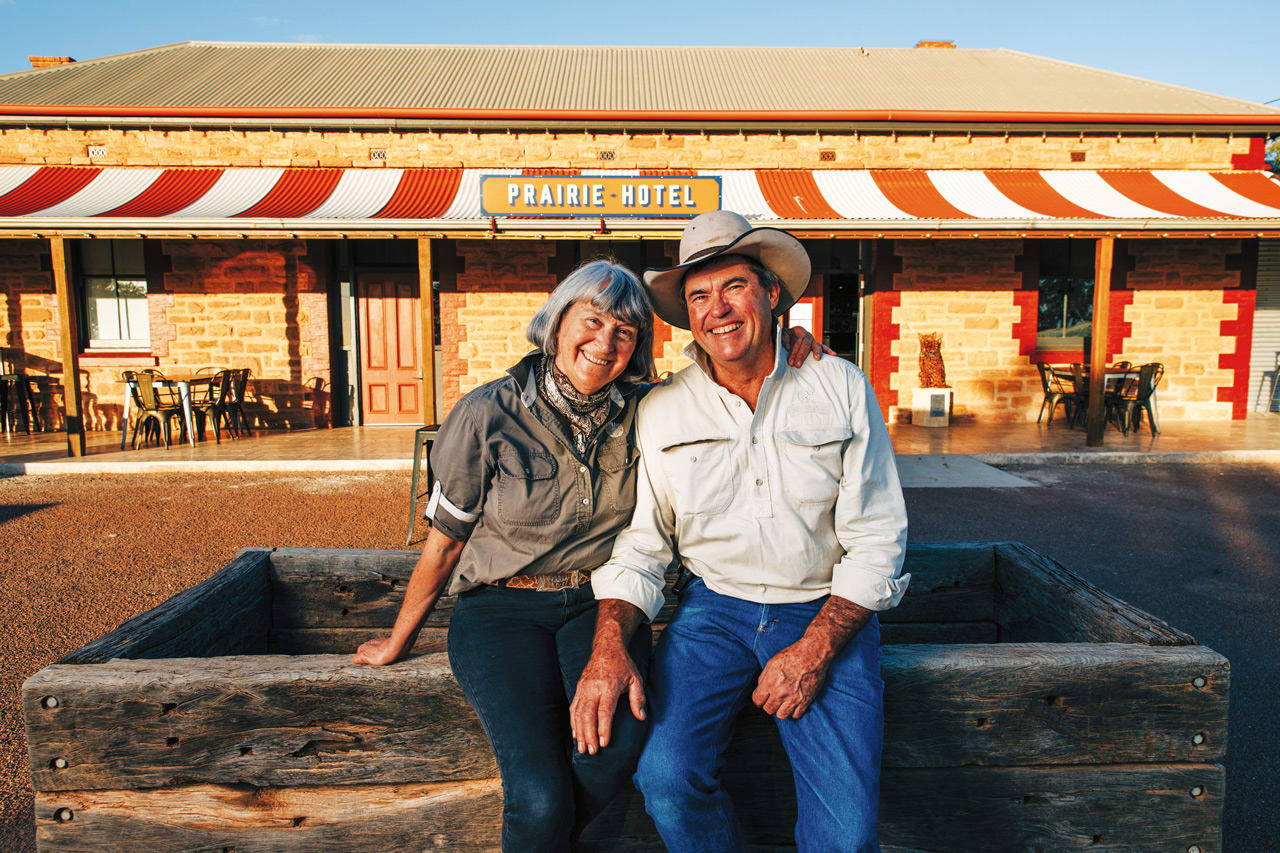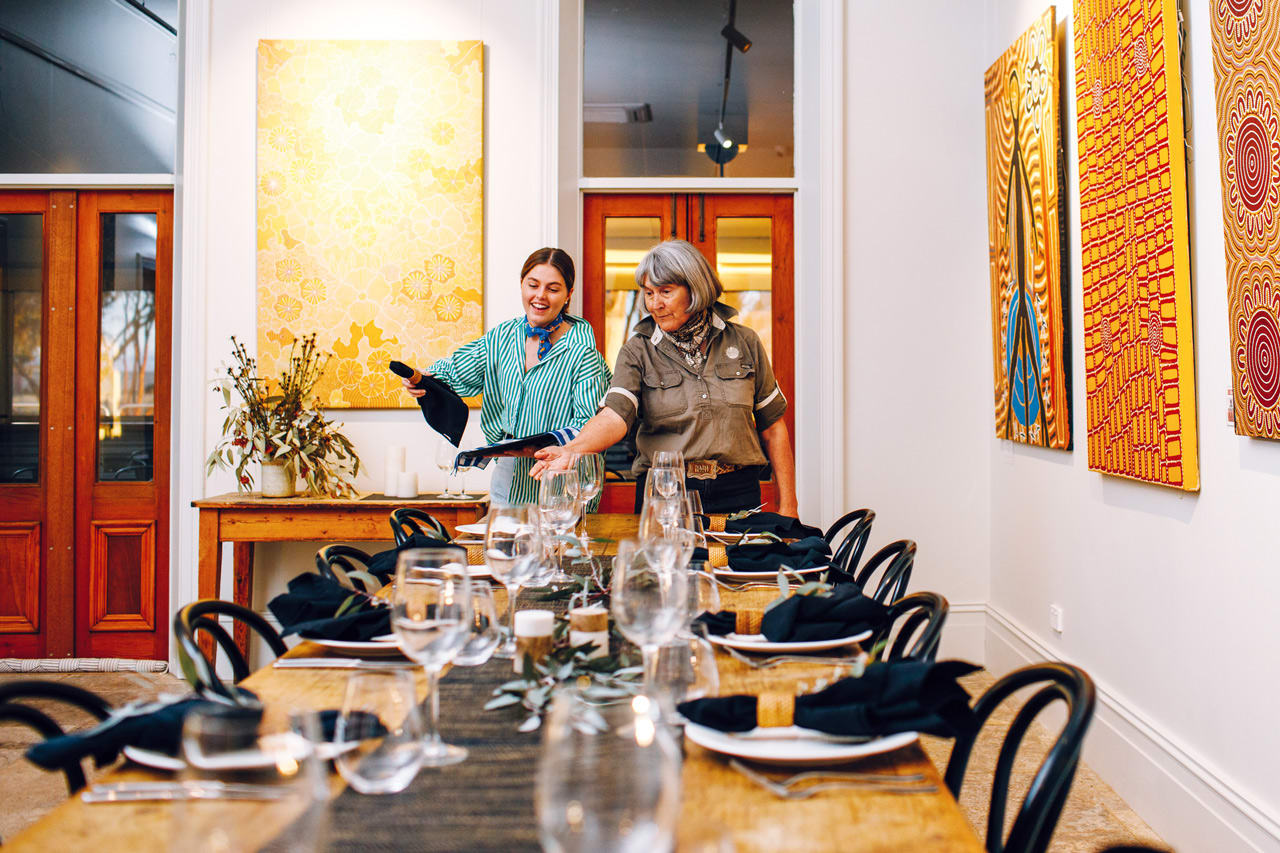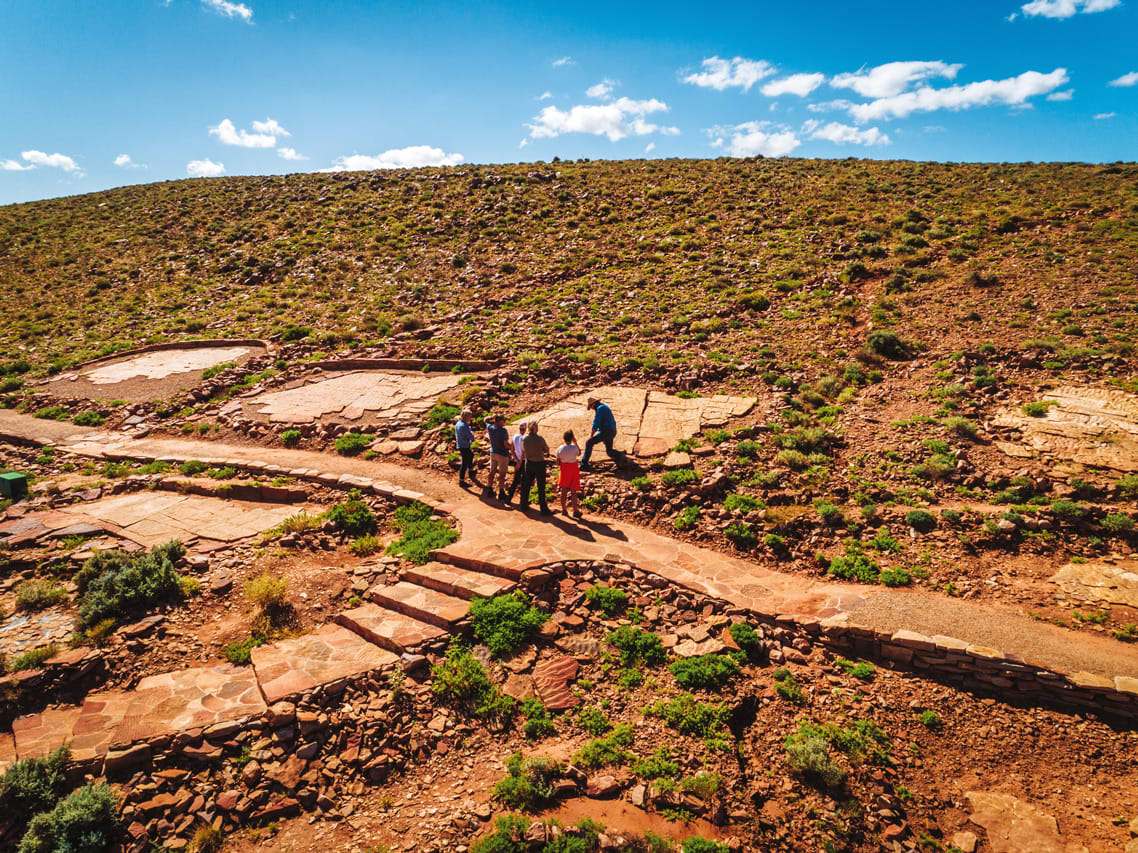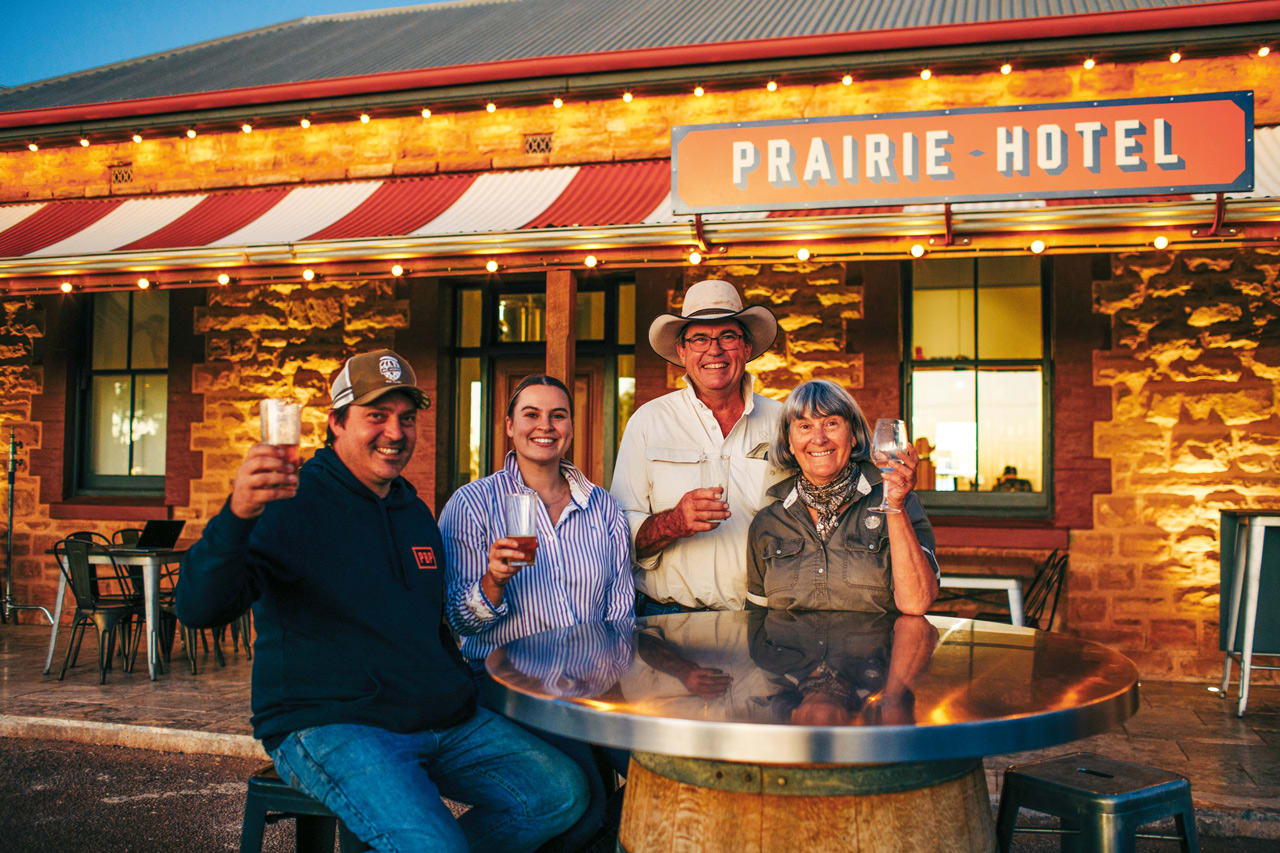
On ancient ground
Dynamo couple Jane and Ross Fargher have injected new life into South Australia’s Flinders Ranges.
STORY GRETEL SNEATH | PHOTOS ROBERT LANG OUTBACK MAGAZINE
At Jane and Ross Fargher’s 1984 wedding, the master of ceremonies marvelled at how frequently the prefix ‘Para’ had popped up in Jane’s life journey. Her father, Glen Goodall, was raised at Para Hills in Adelaide and owned properties called Para Downs and Parakylia. Now, his daughter had moved to Parachilna. “He joked that Ross and I should buy Parachilna’s hotel so that Dad could be permanently Para-lytic, and we all went ‘Ha ha ha’,” Jane says.
At that point, the prospect of running a pub was about as remote as the couple’s new home beyond the western slopes of the Flinders Ranges. Nilpena Station’s 870sq km pastoral lease had recently been taken over by Ross’s parents, Max and Barbara Fargher, who also ran Angorichina and Oratunga near Blinman. Ross was put in charge of Nilpena, with older brother Ian remaining on Angorichina with his wife Di, who is Jane’s sister. “Two brothers marrying 2 sisters – it’s all very rural,” Jane grins.
Before their engagement, Jane was an aspiring manager at Adelaide’s Hilton Hotel, but the shift from shiny 5-star surrounds to a crumbling century-old homestead 500km away wasn’t a huge culture shock; her own family had country near Roxby Downs in the state’s Far North, and Coonalpyn in the Upper South East. “I knew that she had the outback genes,” Ross says.
During the 1870s, up to 45,000 of the district’s sheep were shorn at Nilpena’s 20-stand woolshed, but Ross believed the flatter country was better suited to cattle, and that became the couple’s early focus, along with the arrival of sons, Lachy, now 36, and Eddie, 34. “It was very simple station life that we all enjoyed – mustering, having friends up to stay and barbecues in the sandhills,” Ross reflects.

But then their run-down ‘local’, Parachilna’s Prairie Hotel, hit the market, and life got a whole lot busier. “We got a little bit inspired and saw the opportunity of such a beautiful old stone building, and away it went from there,” Ross says.
With fewer than 10 people living in the town and no passing traffic, it was hardly a hive of activity, but the Farghers saw promise in the lonely hotel beside the old Ghan railway line. “We just knew it was a remarkable location and that it would be an enormous attraction if it were anywhere else in the world, so why not here?” Jane asks.
Jane and Ross purchased the pub in 1991 as part of a small syndicate, but bought out their partners 2 years later to take the business in a radical new direction. The tired bar and bedrooms were transformed and, in a bold move for the times, kangaroo, camel, goat and emu meats headlined the menu. Travellers made a beeline to this ‘outback Hilton’, and it also started capturing the attention of film producers.
“You can’t beat the clarity of the light here, with that magic golden hour, but there’s also the incredible diversity of the Flinders Ranges landscape,” Ross says. “You’ve got deserts, creeks, gorges and ranges all within close proximity.” The Farghers added the missing ingredient: quality accommodation and food. “There are often 100 people in a film crew and they all need places to stay and eat.”
Ross knew little about the movie world until the cameras started rolling in his backyard. “It’s an interesting ride, that’s for sure,” he says. He’s proven to be a very handy location scout, and even scored a role as a second assistant director on Rabbit-Proof Fence, guiding local Aboriginal kids who worked as actors’ doubles. “Wherever you see hands or feet walking along the fence or anywhere without dialogue that doesn’t show faces, that’s usually our local kids,” he says proudly.
Jane also gets caught up in the action, organising catering and accommodation. “Jane’s always been good with food and hosting, and she’s probably more comfortable out the front than I am, but I enjoy the small group interaction of showing people the area that we love so much,” Ross says. “I think there’s a good balance there.”
In the early 1990s, Ross was showing family friends Pam and Geoffrey Hasenohr around Nilpena’s historic woolshed when Pam noticed distinctive ripples on the stone loading platform. “She was a bit of an amateur geologist,” Ross says “She got all excited and said it looked very much like the Ediacaran material she was studying.”

Ancient fossils confirming evidence of life in Precambrian times had been unearthed in the Flinders Ranges by geologist Reg Sprigg in 1946 but were thought to be centred around the Ediacara Hills further north. Pam’s discovery was to prove this wrong. “I wasn’t too keen to pull up the woolshed floor for a closer look, so we drove to a hill where I’d noticed similar rippled stone while mustering,” Ross says. “We flipped over some rocks and realised that there were fossils everywhere.”
Nilpena is now the single most important site on the planet for evidence of the Ediacaran rise of early animal life, with about 60 species recorded so far in the sediments of its ancient sea floors. Two of them – Attenborites janeae and Nilpenia rossi – have been named after the Farghers, and there is also a leaf-like frond fossil called Pambikalbae hasenohrae in honour of Pam Hasenohr. “We have been immortalised in stone,” Jane says.
Every winter for more than 20 years, University of California palaeontologist Dr Mary Droser and her students have travelled to Nilpena with now-retired SA Museum palaeontologist Professor Jim Gehling to study the fossils. “I cannot believe how fortunate we are to have the Farghers own Nilpena,” Mary says. “Most people would not have even allowed us to excavate, much less help facilitate field work at every turn and then protect the locality and work to preserve it for the future with enthusiasm.”
Ross’s passion is clear as he carefully explains their delicate work, joining ancient pieces of stone like a jigsaw to create in situ snapshots of the sea floor as animal life unfolded. “I’ve been able to put my own spin on the story so that everyone can understand it because when you look out at this desolate country, it’s pretty mind-blowing trying to get your head around sea creatures that lived here when the land was under water,” he says.
Ross reckons he’s learned “just enough to be dangerous”. Mary disagrees. In 2017, she nominated him for America’s prestigious Strimple Award for his contribution to furthering the field of palaeontology. “Ross is not a typical Strimple nominee; his dedication is breathtaking,” Mary says. “He is a global role model for recognising the importance of a fossil locality and working to preserve it.”

Jane and Ross flew to Seattle to receive the award before racing back to The Prairie for son Eddie’s wedding that weekend. “The whole period just became a bit of a blur, but it was also a very exciting time as well,” Ross says. “To be the first Australian to receive an award like that was definitely an honour, but I also look at the protection of the fossils as being a family effort. Through the years, we’ve all played a part in their preservation.”
By 2019, the Farghers had become so concerned about the fossils’ conservation that they agreed to sell off 60,000ha of Nilpena to establish the Nilpena Ediacara National Park. “Both of our sons love it out here, but neither wanted to take it over and run it as a cattle enterprise, so we were really worried that if we ever had to sell up, the new owners may not be interested in fossils and might tell everyone to get the hell out of there and just run dorpers or something on those hills,” Ross says. “Our main aim has been to see them protected and now we’ve got to that point. Hopefully, World Heritage listing is next.”
Jane and Ross still have their homestead and the country stretching out to the ranges. They remain committed to fossil tours and are also helping with the establishment of a new interpretive centre due to open this year inside the original blacksmith’s shop.
Over at The Prairie, the couple recently toasted 30 years of ownership with a fresh round of renovations. Lachy oversees the new onsite brewery, with his partner Ellie Gorringe managing The Prairie’s Outback Lodge, while younger son Eddie is a Royal Flying Doctor Service pilot based in Adelaide with his wife Kelly and toddler Albie. The family houseboat on the Murray River at Mannum has become everyone’s favourite meeting spot, and Ross muses that they may even retire there some day. “But we’re not thinking about that yet; seeing people up here enjoying what we’ve got to offer spurs you on.”
The experiences unearthed by the Farghers have attracted many brilliant minds and famous faces over the years, but they avoid singling anyone out. “I know some places make a big thing out of people who have stayed, but we prefer discretion,” Jane says.
“Everyone who comes to stay is important, and that’s one thing that we’ve learnt from doing the fossil tours,” Ross adds. “It doesn’t matter how important you are – or how important you think you might be – you go out to that fossil site and look back to where animal life started 550 million years ago, and it brings everyone back to reality in terms of where we fit in the scale of things.”